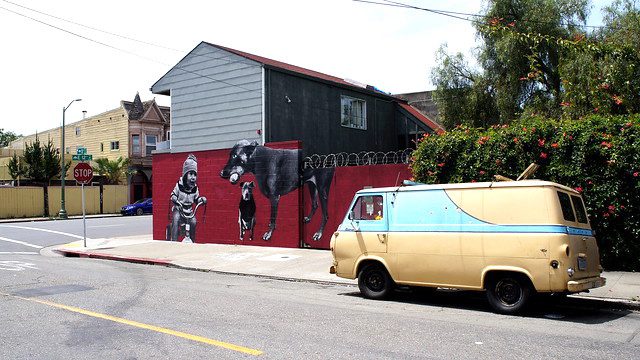
Mural in Oakland, California. Photo by Mateo Bittanti via flickr, CC BY-NC 2.0.
A September 2016 Shelterforce article that I co-authored (based on an article in Housing Policy Debate), argued that housing practitioners needed to adopt a new perspective on housing tenure. This new perspective pays greater attention to the vast diversity of housing tenures in the United States and works to move beyond either a “rent vs. own” dichotomy or an exclusive focus on alternative, third way tenures. It also seeks to ask more specific questions about which tenures are riskier and why, and which tenures are supported by policy, political advocacy, or subsidies.
In the years since, we collaborated with the Oakland Community Land Trust (OAKCLT) and local researcher Anna Cash to develop Housing Vulnerability Analysis, a new way of assessing tenure-based vulnerability in any given jurisdiction. An initial pilot study was developed for Oakland, California, that identified 56 different housing tenures, each with different degrees of legal protection, political and advocacy support, and with very different types of risk. While the study focused at the city level, the analysis demonstrated a methodology that could be replicated at different geographic scales, including county, regional, and state levels.
The pilot was developed with input and collaboration from a diverse range of housing advocates in the city and region, and Housing and Economic Rights Advocates (HERA), a state-wide, nonprofit legal service and economic justice organization, joined the project as a key collaborator early on.
The Oakland pilot yielded a series of key findings. In terms of legal protections, the biggest gap are the approximately 77,000+ tenants of single family homes, one of the fastest growing tenures in the country in the wake of the foreclosure crisis. Doubled up residents, renters in buildings at risk of condo conversions, low-income homeowners, and market-rate residents also showed serious vulnerability.
On the advocacy/political side, we found that many tenure groups, including low-income homeowners, lacked dedicated advocates or advocates with enough capacity to meet their needs.
Below is a Q&A discussion with HERA executive director Maeve Elise Brown and OAKCLT executive director Steve King about why this type of analysis is necessary in the current iteration of our perpetual housing crisis.
Why do you and your organizations think it is important that we talk about housing tenure? What do you think this analysis shows us that housing politics often ignores?
Maeve Elise Brown: At HERA, we think a discussion of housing tenure is essential for understanding how to increase the housing security of residents, both tenants and homeowners. We work with low and moderate income Californians living across a broad spectrum of housing tenures— from homeless shelters, transitional housing, subsidized housing rentals, or living out of a vehicle, to living as renters or owners of a single family home, a condominium, or mobile home. It is not only the type of housing that matters, but each resident’s relationship to that housing. Does the resident have a written agreement as a renter? Do they have a roommate situation with no written agreement regarding their status in the housing? Do they consider themselves to be homeowners but are not on title to the home? We have to go beyond the type of housing as a starting place for analyzing the risk of displacement or likelihood of stability—we must understand how the legal framework that governs each housing tenure has a direct impact on answering the question of risk.
An analysis rooted in housing tenure provides a deeper dive into the types of risk [inherent to residents based on the] type of housing situation. This type of analysis begins to provide the framework for a more accurate determination of which types of tenure are most risky to residents and why, which in turn can lead to policy solutions and services solutions to better support residents living in the riskiest tenures. At HERA, we think a next step in this analysis is to then layer on additional information so that service providers, residents, and government can understand the interaction between housing tenure risk and the vulnerabilities of residents.
HERA provides direct legal services to residents with the goal of stabilizing households, whether through addressing their student loan debt problem, helping [them] improve their credit, or saving the[ir] family home from foreclosure. Over the years, we have found that residents go into various types of housing tenure with a sometimes murky or completely inaccurate understanding of the risk they are incurring. For example, many residents strive for homeownership with the belief that becoming a homeowner will give them complete power to decide what their home should look like, and what they can store on their property. After all, it does belong to them, right? They imagine that it will give them [the] “independence” that they don’t have as renters. They do not realize that they will, as homeowners, be subject to city or county decisions that affect their property tax bill, and that they cannot build a fence anywhere they want on their property with any materials they want and at any height, or that they will probably not be able to park as many cars on their [property] as they want. Just recently, HERA staff counseled a condo owner who thought he could [avoid] paying a special assessment that he disagreed with simply by signing a declaration saying that he disagreed. Residents, renters and homeowners alike, will let friends move in with them, believing they can tell those friends at any point in time to leave, not realizing that there are protective laws that they have to comply with.
Steve King: I think one of the most instructive aspects of the analysis is how it calls out, in a productive way, the overly simplistic way that tenure is treated in most housing policy or program contexts. We are amazingly still stuck in a reductive rent versus own framework that clearly does not correspond to the myriad ways that people actually live. The analysis demonstrates that experiences of tenure in the real world are far more complicated and nuanced—[with] many variations of tenure that fall on a broad continuum.
Wearing my hat as a community land trust (CLT) advocate and practitioner, the analysis is affirming of innovative tenure arrangements that stray from the either/or of rent versus ownership. One of the persistent challenges that CLTs face is simply carving out room to operate amidst this dominant framework. This prevailing narrative limits our collective ability to imagine alternative tenure possibilities, let alone support and scale them in meaningful ways.
I have hope that a broader recognition of the multitude of actually-existing tenure types (the HVA identified 56 distinguishable tenures in Oakland alone) will open up space for an honest dialogue about why certain tenures are more privileged and supported (via tax policy, municipal programs, financing products, etc.) than others, and how this status quo might perpetuate racial and socio-economic disparities in housing and land ownership.
This analysis focuses on vulnerability. Why is this so important right now? What is the link between vulnerability and the housing crisis?
Steve King: The organization that I am a part of (the Oakland Community Land Trust) was created in 2009, just as conventional market rate single-family homeownership was revealing its potential to be one of the most risky tenure types imaginable. Not only were families dispossessed of their housing, many were also stripped of their hard-fought, intergenerational wealth as a result of predatory mortgage lending. As the nature of the crisis has evolved in Oakland, eviction and homelessness have skyrocketed alongside rising rents and home prices. Even in a city with relatively robust tenant protections, vulnerability has become a palpable, persistent feature of Oakland’s housing landscape— particularly for long-time renters, low-income households, and communities of color. The reality is that many Oaklanders can now see a clear trajectory from buying a home to facing foreclosure to leasing a non-rent-controlled apartment to no-fault eviction to sleeping in their car.
Seeing the broad continuum of housing tenures in a comparative way with a [focus on] their precarity or stability begs essential questions about our entire housing ecosystem. Given the intensity of the crisis in Oakland and many other places, we must take action to reduce the relative harm introduced by certain tenure types and prioritize others that are unequivocally more safe, stable, and equitable.
Maeve Elise Brown: Analyses of vulnerability by housing tenure type is more important than ever because, in high-cost parts of the country in particular, someone who loses housing (renter or homeowner) is at risk of having to relocate out of the area in order to remain housed. While this is important at any time, it is all the more important in the context of our aging society and rising homeless population. Older adults are likely to experience a decrease in income, leaving them more vulnerable to displacement from rising rental costs or, if they are homeowners, vulnerable to the rising cost of needed home repairs to maintain the structure. What was the measure of risk for older adults by housing tenure?
At this time, not only are 28,000 Bay Area residents homeless, but two-thirds are living on the street or in a vehicle, which is a rate that is double the national average. Even as supportive housing and other housing resources to serve homeless residents grew between 2011 and 2017, the homeless population continued to grow. Housing tenure analyses could help us better understand which types of housing tenure are the least stable, and for whom, so we can make better services and policy choices to protect residents.
Thank you.






Comments